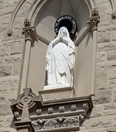Big Ideas for Catechism: Difference between revisions
adding proper attire to big idea no. 10 The Mass |
|||
| Line 109: | Line 109: | ||
** Transubstantiation | ** Transubstantiation | ||
* attendance at Mass | * attendance at Mass | ||
* proper attire for Mass | |||
== The Bible == | == The Bible == | ||
| Line 135: | Line 136: | ||
=== Church as Bride of Christ === | === Church as Bride of Christ === | ||
=== Creed === | === The Creed === | ||
=== Gifts and Fruits of the Holy Spirit === | === Gifts and Fruits of the Holy Spirit === | ||
| Line 143: | Line 144: | ||
=== Rosary === | === Rosary === | ||
=== Saints === | === The Saints === | ||
=== Typology === | === Typology === | ||
Revision as of 15:56, 17 April 2024
Big Ideas for Catechism / Catechesis
In preparation for catechesis, or the learning of the Catholic faith and preparation for life in Christ, students (catechumens) may prepare for deeper understanding of the faith and its lessons by developing first a set for fundamental, or foundational ideas.
Note: these are not from the Catholic Church, but developed by a Catechist
The "Big Ideas" represent necessary concepts for students to know in order to access higher order concepts for their catechism.
- none of these ideas are sufficient alone to understand the Catholic Faith and develop Life in Christ
- but all of these ideas are necessary for that understanding
BIG IDEAS: Ten Fundamental Concepts
For understanding and practicing the Christian Faith, Catechumens (students of the Catechism) can use these fundamental, or underlying, ideas to apply to their general learning about the Catholic Faith and Life in Christ.
1. Jesus Christ
- Jesus = "God saves"
- Christ = "Messiah" = "Mission"
- the "Mission" of "Christ" is to save us from sin
- the God-man, mystical union, person of Christ
- = Hypostatic Union
- St. Anselm's formulation of salvation:
- "For God will not do it, because he has no debt to pay; and man will not do it, because he cannot."
2. The Trinity
- one God, three persons
- "person" = perspective
- God in the "persons" of the Father, the Son and the Holy Spirit
- one God, three natures
- nature" = form of
- God in the "natures" of the Creator, the Savior, and the Sanctifier
- The Word per Genesis and John 1:1
- God's existence outside of time and creation
3. Sin
- separation from God
- the word "devil" comes from Greek diaballein, for "throw across, separate
- thus Satin wants to separate us from God
- Hell is eternal separation from God
- the Fall of Adam and Eve and its implications
- the word "devil" comes from Greek diaballein, for "throw across, separate
- Israel breaking God's commands
- God's "Plan of Redemption"
- "Dying to sin, living in Christ"
- State of Grace
- Sacrament of Reconciliation
4. Thoughtful worship
- understanding Scripture through the "Four Senses of Scripture"
- esp. for recognizing implications in Biblical passages beyond the literal word
- ex. Fourth Commandment to "Honor your father and your mother"
- extension = obey all legitimate authority
- ex. Fourth Commandment to "Honor your father and your mother"
- applying Jesus' clarifications
- ex. “You shall love the Lord, your God, with all your heart, with all your soul, and with all your mind.” (Mt 22:37)
- what implication comes from loving God with "all" your heart, soul, mind?
- ex. “You shall love the Lord, your God, with all your heart, with all your soul, and with all your mind.” (Mt 22:37)
- esp. for recognizing implications in Biblical passages beyond the literal word
- seeking God and truth through the "Two Wings" of the Gifts of Faith and Reason
- praying thoughtfully and purposefully
- Sign of the Cross: what do you think about when making the Sign of the Cross?
- Lord's Prayer: the Seven Petitions
- The Liturgy: knowing the Mass
5. Sermon on the Mount and The Beatitudes
- Life in Christ
- Christ's New Commandments
- Ten Commandments & Christ's clarifications of Mosaic Law
- ex. murder and adultery start in the heart
6. Christ as fulfillment of the Old Testament
- "testament" means "covenant"
- Covenant = God's loving design and gift to mankind
- The History of Salvation
- God's promises are expressed in the "Covenants"
- Covenant = God's loving design and gift to mankind
- Jesus fulfills the "Old Covenant" and gives us the "New Testament"
- Introduction to Typology
7. The Mysteries
- understanding the seen and unseen
- identifying what is mysterious
- using the Wing of Faith
- recognizing the limits of Reason
- limits of reason, senses, and subject to concupiscence
8. Sacraments
- the seen and unseen
- the Holy Spirit
- types and purposes
9. Lord's Prayer
- taught by Christ
- Seven petitions
- role and purpose of prayer in general
10. The Mass
- Real presence of Christ
- role of the Priest
- Parts of the Mass and their purpose and implications on worship
- The Eucharist and Holy Communion
- Transubstantiation
- attendance at Mass
- proper attire for Mass
The Bible
- Divinely "inspired"
- Student familiarity with the Bible
- its parts and organization
- actually using the Bible
- finding passages
- flipping through pages
- using Biblical references
- applying Biblical knowledge to Liturgy of the Word
The Catechism of the Catholic Church
- Student familiarity and comfort with the Catechism
- purpose
- structure
- format
- abbreviations
- vocabulary
Next Priorities for Catechesis
in alphabetical order, not order of importance
